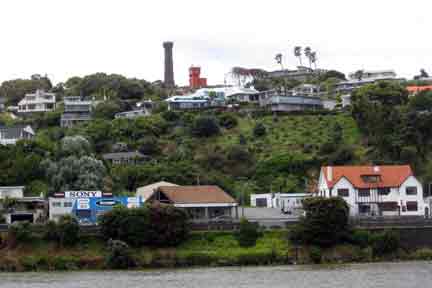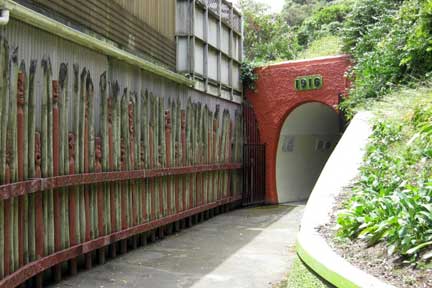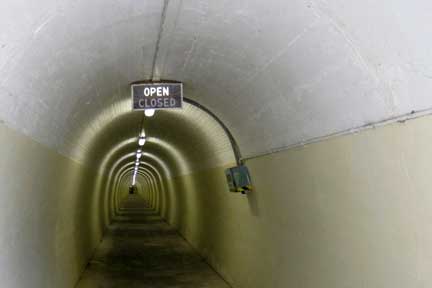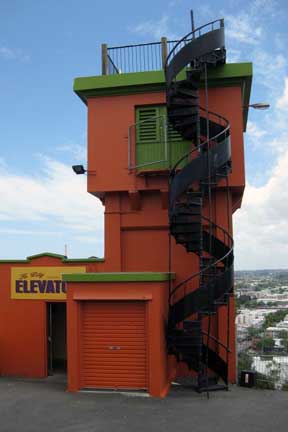The following is a guest post by Wellington Cycleways’ Matt Thredgold.
Steven asks us what we can learn from elevators. He notes that they are the world’s most used form of public transit. It is perhaps stretching the definition of public transit a bit to include elevators, but in some places in the world elevators are doing exactly that. And as a form of cable propelled transit, I think it is worth noting some of the places where elevators are being used for public transit.
Think about the Polanco elevator. As I’ve noted before on a post about the ascensors of Valparaiso, the Polanco elevator combines an elevator, a bridge and a tunnel to get people up a hill in that corner of Valpo.
Despite being so ubiquitous in buildings, public elevators used as a form of intermediary mass transit are not found in that many places around the world. They’re used perhaps to access underground stations, or to get to elevated railway station platforms, but they’d be rarely thought of as transit in their own right.
However they are in Stockholm, Lisbon, Oregon City, Salvador and Whanganui, New Zealand.
Yes, Whangnui, a small city on the Whanganui River on the North Island of New Zealand, an hour west of Palmerston North (known to Gondola Project readers for the Palmylink Proposal), and three hours north of Wellington (known to Gondola Project readers for its famous cable car).
From the city centre it is a short walk across the bridge to a pedestrian tunnel, built in 1916, which leads 205 metres inside Durie Hill. The tunnel and elevator were built by a real estate developer in order to sell the land of the original subdivision atop Durie Hill.
Here’s some pictures:

The two elevator towers can be seen on top of the hill. Interestingly the two towers were not used in Peter Jackson's Lord of the Rings trilogy, unlike every other notable bit of New Zealand.

The entrance to the elevator's tunnel is decorated with interesting Maori carvings. The gates shut when the elevator is not in service. For those times there is a flight of 191 stairs that lead up the hill (bring a Slinky).

The 205 meter long tunnel. Strictly speaking it is an "adit", not a tunnel, as there is only one entrance. But call it an adit and people won't know what you are talking about. At the end is a call button. Push it and wait for the elevator doors to open. A friendly operator lets you in and charges you $2.00 to go up. (Kids are a $1.00). They'll take bikes as well if they're not too busy. The interior is wood panelled and is in quite good condition for being over 90 years old.


10 Comments
nice post matt
http://www.youtube.com/watch?v=ltwxC19s5u8 !!
Speaking of public transit elevators, if my memory serves me correctly, Monaco has quite a system of public tunnels/escalators/elevators in the city, since it is build on a narrow strip of steep hillside along the ocean.
See this wikipedia article for (very) basic information:
http://en.wikipedia.org/wiki/Transport_in_Monaco#Elevators_.2F_travelators
Does anyone know the meaning of the maori faces that decorate the wall to the entrance of the “tunnel”?
@ Karen,
Probably be best to ask Matt Thredgold that one.
I just saw this comment.
I’ve no idea about their meaning, sorry. I’m an ex-pat Australian, newly arrived in NZ, and still clueless on Aotearoan culture.
This brings back memories!
I was a Postman back in the Seventies,and remember doing the Durie Hill/Putiki postie run….WHAT GREAT DAYS!…I now live in Melbourne,Australia….However,those days of biking through that adit,then finding a sign saying “Out of Order”on the Lift made my heart break knowing I had to bike back out,then carry my bike (with full mail in three bags) up the wooden steps to the top of “The Hill”….But,Yes,I would do it again…I remember it,And miss it.
Tony Robb.